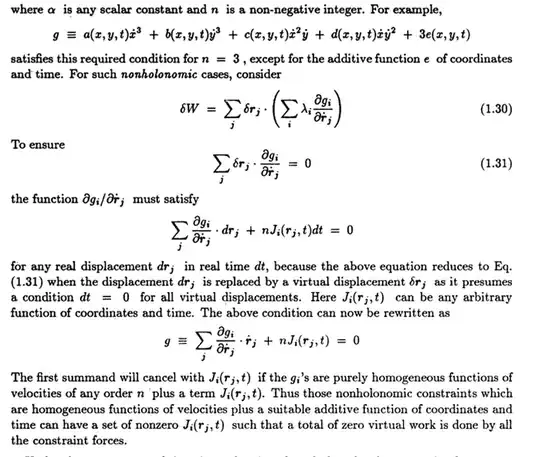I was reading classical mechanics by NC Rana. I was reading a topic on vanishing virtual work done due to constraint forces. How do you prove that the virtual work done by non-holonomic constraint which are homogeneous functions of velocities is zero? There is a proof given in the text but i find it unclear. How did he proceed after eq 1.31. It says the first summand will cancel with $J(r , t)$. How?
1 Answers
Ref. 1 is effectively considering $m$ independent non-holonomic constraints of the form$^1$ $$ f_{\ell}(q,\dot{q},t)~\equiv~\underbrace{g_{\ell}(q,\dot{q},t)}_{=\frac{1}{n}\dot{q}^j\frac{\partial g_{\ell}(q,\dot{q},t)}{\partial \dot{q}^j}}+J_{\ell}(q,t)~=~0, \qquad \ell~\in\{1,\dots,m\}, $$ which equivalently can be written as $m$ independent non-holonomic one-form constraints of the form $$ \omega_{\ell}~\equiv~\frac{1}{n}\frac{\partial g_{\ell}(q,\dot{q},t)}{\partial \dot{q}^j}\mathrm{d}q^j+ J_{\ell}(q,t)\mathrm{d}t~=~0, \qquad \ell~\in\{1,\dots,m\}.$$ For an infinitesimal virtual displacement with frozen time $\delta t=0$, they satisfy $$ \frac{1}{n}\frac{\partial g_{\ell}(q,\dot{q},t)}{\partial \dot{q}^j}\delta q^j~=~0, \qquad \ell~\in\{1,\dots,m\}.\tag{1.31}$$ One can therefore add such terms (times Lagrange multipliers) to d'Alembert's principle (DAP) and Lagrange equations (LE), cf. e.g. eq. (2.74) and my Phys.SE answer here.
References:
- N.C. Rana & P.S. Joag, Classical Mechanics, 1991; p. 47 + 85.
--
$^1$ Here we assume that the functions $g_{\ell}(q,\dot{q},t)$ are homogeneous of order $n>0$ in the generalized velocities, cf. eq. (1.29).
- 220,844

